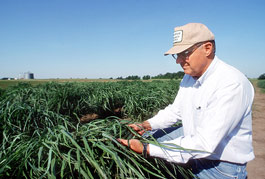Biofuels are transportation fuels like ethanol and biodiesel that are made from biomass materials. These fuels are usually blended with petroleum fuels (gasoline and diesel fuel), but they can also be used on their own. Using ethanol or biodiesel means less gasoline and diesel fuel is burned, which can reduce the amount of crude oil imported from other countries. Ethanol and biodiesel are also cleaner-burning fuels than pure gasoline and diesel fuel.
What is ethanol?
Ethanol is an alcohol fuel made from the sugars found in grains like corn, sorghum, and barley.

Photo Credit: Brett Hampton, USDA Agricultural Research Sevice (Public Domain)
Other sources of sugars to produce ethanol include
- Sugar cane
- Sugar beets
- Potato skins
- Rice
- Yard clippings
- Tree bark
- Switchgrass
Most of the fuel ethanol used in the United States is distilled from corn. Scientists are working on ways to make ethanol from all parts of plants and trees rather than just grain. Farmers are experimenting with fast-growing woody crops such as small poplar and willow trees and switchgrass to see if they can be used to produce ethanol.
Ethanol is blended with gasoline

Source: Stock photography (copyrighted)
Nearly all of the gasoline now sold in the United States is about 10% ethanol by volume. Any gasoline-powered engine in the United States can use E10 (gasoline with 10% ethanol), but only specific types of vehicles can use mixtures with fuel containing more than 10% ethanol. A flexible-fuel vehicle can use gasoline with ethanol content greater than 10%. The U.S. Environmental Protection Agency ruled in October 2010 that cars and light trucks of model year 2007 and newer can use E15 (gasoline with 15% ethanol). E85, a fuel that contains 51%–83% ethanol, depending on location and season, is mainly sold in the Midwest and can only be used in a flexible-fuel vehicle.
What is biodiesel?
Biodiesel is a fuel made from vegetable oils, fats, or greases—such as recycled restaurant grease. Biodiesel fuel can be used in diesel engines without changing the engine. Pure biodiesel is non-toxic, biodegradable, and produces lower levels of most air pollutants than petroleum-based diesel fuel. Biodiesel is usually sold as a blend of biodiesel and petroleum-based diesel fuel. A common blend of diesel fuel is B20, which is 20% biodiesel.



